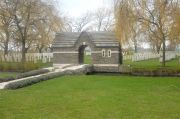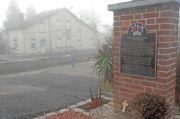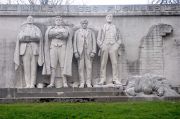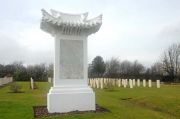 |

|
 ND de Lorette cemetery© T.Joly ND de Lorette cemetery© T.Joly

|
Four remembrance trails help you discover First World War sites in Northern France. A journey though the horrors of this war in the footsteps of soldiers from more than forty countries.
[ Practical ]
Getting there
- By Road
180 km from Paris to Arras on autoroute A1 till exit 15, then on D939 and D260.
225 km from Paris to Lille on autoroute A1.
- By train
TGV from Paris Gare du Nord to Arras and Lille. The journey takes 50 mn to Arras and 1 hour to Lille.
Lodging
- Arras
Hôtel de l’Univers
Mercure Atria
Ibis
- Montreuil / Mer
Coq Hôtel
Hôtel Hermitage
- Lens
Lensotel
Campanile
- Lille
Hermitage Gantois
Hôtel Bellevue
Ibis Centre Gares
Novotel Centre Grand Place
- Valenciennes
Auberge du Bon Fermier
Restaurants
- Armentières
A Ch’Carrefour Gourmand
- Arras
Le Clusius
La Part des Anges
Le Petit Rat Porteur
- Avion (near Lens)
A l’Fosse 7
- Lens
Le Bouchot
Le Pain de la Bouche
- Lille
L’Atelier Gourmand
Le Cant’in
Jour de pêche
- Montreuil / Mer
Hôtel Hermitage
Le Cocquempot
- Valenciennes
Auberge du Bon Fermier
Getting around
It is necessary to have a car to get to the cemeteries and other sites.
Information
- Nord – Pas de Calais Tourist Office
Tel : 0320145757
www.tourisme-nordpasdecalais.fr
www.remembrancetrails-northernfrance.com
For over four years World War One raged on, leaving in its wake a toll of death and destruction such as the world had never seen, and both Nord and Pas de Calais departments were always one of the main theatre of operations. That’s why this region boasts no less than 600 military cemeteries, including 500 from the Commonwealth War Graves Commission, as well as hundreds of ruins, remains and monuments reminding of large offensives, heroic actions, destructions and resistance acts. This concentration – probably unique in the word – highlights the intensity and the fierceness of the fighting as well as the international aspect of this war.
 Soldiers from all over the world Soldiers from all over the world
Indeed, men from more than 40 countries fought on Northern France soil and not all of these countries existed at the time of the war. Many of them were still French or British colonies. It’s because - from 1915 onwards - the French Army gradually handed over this sector of the front to Commonwealth troops as French units moved to Champagne and Verdun.
So, every year battlefields from Nord and Pas-de-Calais departments welcome visitors from all other the world coming to discover the places where their compatriots fought, gather at their graves and learn more about the Great War.
Very helpful for tourists, a website list the most iconic, the most significant of these sites and offers four remembrance trails, each one focusing on a specific theme. The Western front. The war of movement and the first German occupation. The Allie’s logistics base on the Channel coast. Post-war reconstruction.

 Ring of Remembrance © Philippe Prost Ring of Remembrance © Philippe Prost
|
 Ring of Remembrance Ring of Remembrance
The most impressive and most moving is without doubt “The Western Front”. Following the front line that remained practically stable from late 1914 to early 1918, it indeed passes by most of the military cemeteries and the incredible size of some of them is a poignant reminder of the horrors of this war. The French National War cemetery at Notre-Dame de Lorette thus comprises 20 000 graves and eight ossuaries holding the remains of some 22 000 unknown soldiers from France or colonies such as Morocco or Senegal. They died in May 1915 when French troops attempted to wrest control of the Pas-de-Calais coal basin but it ended without any territorial gain except the ridge where the cemetery is established. Nearby, a Ring of Remembrance recently inaugurated is etched with all 580,000 names of the soldiers who died in the French Flanders and in the Artois region between 1914 and 1918, regardless of their nationalities, their religion or their grades.
In the plain below are two monuments dedicated to Polish and Czechoslovak fighters, some of them being buried in a small cemetery.
 Canadian historic site Canadian historic site
They were immigrants living in and around Paris at the outbreak of the war who were quick to enrol in the French army and they died during this May 1915 attack.
At short distance stands the Cabaret Rouge British cemetery created in 1917 to concentrate the graves of 103 burial grounds spread along the front line. Canada’s unknown soldier resting under Ottawa’s National War Memorial comes from there. A few kilometres further, at Neuville-Saint-Vaast, the Maison Blanche German War cemetery is the largest in France. 44 800 soldiers rest there, most of the time four under each metallic cross, because it was created by the French who didn’t want to give too much land to their enemy. On the top of the ridge towering over the Eastern side of this plain stands Vimy Ridge Historic Site. It’s there, on April 10th, 1917, that Canadian troops fought all together for the first time within the same Army corpse and it marks a defining event in the history of Canada. Facing the coal basin where were the German lines, the grandiose memorial is surrounded with a park where rest 11 285 Canadian soldiers.
 Indian Memorial Indian Memorial
About 20 km to the North, at Richebourg, you will find the Neuve-Chapelle Indian Memorial, the only place of remembrance on the Western front to honour the Army of India and its shape is inspired by the traditional architecture of this country. It holds the remains of 4 000 soldiers killed in March 1915. A few hundred meters away, a cemetery houses the tombs of more than 1 800 Portuguese soldiers whose unit placed under British command was brushed aside by the German army in April 1918. Slightly further North, not far from Lille, in the sector where Adolf Hitler served as a corporal in a Bavarian regiment, the Fromelles cemetery was only inaugurated on July 19th, 2010. The Commonwealth War Graves Commission decided its creation to hold the recently discovered remains of Australian soldiers. It is next to an Australian Memorial Park built to honour the memory of more than 5 000 soldiers killed on July 19th, 1916, the day they first fought in action on European soil.

 Trou Aid Post cemetery © T.Joly Trou Aid Post cemetery © T.Joly
|
 Moving sculpture and peaceful cemetery Moving sculpture and peaceful cemetery
A statue depicts Sergeant Fraser with a wounded man on his shoulders, carrying him to safety and the work is appropriately entitled “Cobbers” because on that day rescuers heard their wounded comrades calling out “Don’t forget me Cobber”. In striking contrast to this work, the nearby Trou Aid Post cemetery looks very peaceful. Built on the location of a former aid post, encircled by a moat and crowned with weeping willows, it is the most beautiful in the region.
South to Vimy, around Arras, are located more cemeteries. For instance in Tricheux where rest in peace the grandson of Indian chief Sitting Bull who fought in a Canadian regiment. Or in Grevillers that boasts a Memorial erected in honour of the 450 soldiers from New Zealand who were killed in action in 1918 but have no known grave. It stands in a cemetery that is the last resting place of more than 2 000 men and many of them were declared DOD (Died of Disease).

 Wellington quarry © T.Joly Wellington quarry © T.Joly
|
 Hidden in an underground quarry Hidden in an underground quarry
They probably succumbed to the Spanish Flu that killed between 20 and 40 millions people around the world in 1918 and 1919. Like in the other British resting places, graves holding unknown soldiers bear the inscription “Known unto God” that was invented by Rudyard Kipling. The famous writer indeed spent months crisscrossing the region in Rolls Royce in hope to find the body of his only son killed in the Loos battle in 1915. But John Kipling’s grave was only identified in 1991 and is located in the British cemetery of Sainte-Marie-de-Haisnes, near Lens.
However, this trail following the front is not only made up of cemeteries. At Monchy-le-Preux, a bronze statue depicting a caribou stands on the ruins of a German fortified post and commemorate the bravery of Newfoundland soldiers. But the most astonishing site is the Wellington Quarry, in Arras.

 Commemorative plate for Wilfred Owen © T.Joly Commemorative plate for Wilfred Owen © T.Joly
|
 English poet Wilfred Owen English poet Wilfred Owen
It’s an old underground chalk-quarry which existed under the town whose tunnels were extended by miners from New Zealand to get close from the German lines. In April 1917, 20 000 men were thus gradually gathered together in the quarry and on the 9th their surge out of their underground hiding and surprised the enemy. A not to be missed visit.
The trail named “The war of movement and the first German occupation” also includes some sites worth a detour. Wilfred Owen, the most famous poet of the First World War, is buried in Ors communal cemetery and a memorial in his honour has been created. It is located just outside this little village, in the house, where he spent his last night before his death on November 4th 1918, trying to cross the Sambre Canal in Ors. In the same area, the town of Le Quesnoy boasts a New Zealand Memorial reminding of it was liberated by New Zealand troops who scaled the Vauban fortifications using simple wooden ladders.

 Monument to the Executed © T.Joly Monument to the Executed © T.Joly
|
 Executed civilians Executed civilians
At Maubeuge, in 1914 the Leveau Fort sustained a two weeks long siege – the longest of the war – and is now a museum telling the story of the fighting and the occupation. According to some historians, this occupation was as harsh as WW2 one and the German Army executed dozens of civilians who passed information to Allies and helped aviators evade capture. The Monument to the Executed of Lille pays tribute to all the men of the resistance who lost their life. Nearby, in front of the Zoo entrance stands a memorial to the 20 000 pigeons who died for their country and to the pigeon fanciers who were executed by the enemy for having kept them and sent messages to Allies. It’s the only memorial in France dedicated to animals !!!
Located along the “The Allie’s logistics base on the Channel coast” trail, the little town of Montreuil-sur-Mer became in 1916 the headquarters of Field Marshal Douglas Haig and subsequently the British Army’s centre of operation for the supply of troops, provisions and equipments to the front.

 Saint-Etienne-au-Mont cemetery © T.Joly Saint-Etienne-au-Mont cemetery © T.Joly
|
 Chinese labourers Chinese labourers
Italy and United States even set up embassies in town while other countries opened military representations. An equestrian statue of Douglas Haig and a museum installed in the citadel remind of this time. As to the fishing port of Etaples, it became a giant training camp for recruits coming from all parts of the Commonwealth with 40 barracks accommodating 80 000 to 100 000 men. There was also a vast hospital complex treating the wounded soldiers evacuated from the front. It only remains the cemetery, final resting place of 11 500 soldiers, and so the Commonwealth ‘s largest in France. In the communal cemetery of the nearby village of Saint-Etienne-au-Mont, a stone pagoda marks the burial site of 160 Chinese labourers as well as a few South Africans. In order to free up its fighting force from non-military tasks, the British Army indeed recruited civilian volunteers from Commonwealth countries such as Egypt, India and South Africa but also Chinese from Manchuria.

 Armentières city hall © T.Joly Armentières city hall © T.Joly
|
 Post-war reconstructions Post-war reconstructions
They carried out under military command manual tasks behind the front : unloading ships, handlings ammunition and materials in depots, cutting off wood to maintain and built trenches,.. In 1919 about 80 000 of them were still at work cleaning up the battlefields. And how many died in France ?.. Nobody knows exactly.
After the war ended, reconstruction took years. Depending on the towns and the architects, destroyed historic districts and monuments where either identically rebuilt or replaced with modern buildings. The “Post-war reconstruction” trail shows you both examples. At Lens, capital of the coal basin, the new railway station made in reinforced concrete was given the shape of a steam engine locomotive. At Baillleul and Armentières architects mixed modern urban principles with traditional Flemish architecture. At Arras, the main square and the belfry were reconstructed identical to the original ones and are among the tourist highlights of the region.
October 30, 2014
Thierry Joly 

|



